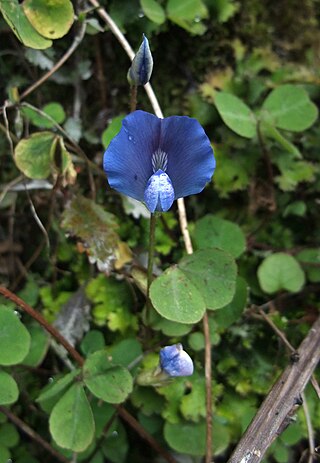
Parochetus communis, known in English as shamrock pea or blue oxalis, is a species of legume, and the only species in the genus Parochetus and in the subtribe Parochetinae. It is a low-growing plant with blue papilionaceous flowers and clover-like leaves. It is found in the mountains of Asia and tropical Africa, and has been introduced to New Zealand.
Erythrina schliebenii is a species of legume in the family Fabaceae. It is found only in Tanzania. The species is named for German collector and botanist Hans-Joachim Schlieben.

Afromorus mesozygia, known as black mulberry or African mulberry, is the only species in the genus Afromorus. The plant is a small- to medium-sized forest tree of Tropical Africa. Its leaves and fruit provide food for the mantled guereza, a colobus monkey native to much of Tropical Africa, and for the common chimpanzee of West and Central Africa. It is also a commercial hardwood.

Ocimum americanum, known as American basil, lime basil, or hoary basil, is a species of annual herb in the family Lamiaceae. Despite the misleading name, it is native to Africa, the Indian Subcontinent, China, and Southeast Asia. The species is naturalized in Queensland, Christmas Island, and parts of tropical America.

Aframomum zambesiacum is a species in the ginger family, Zingiberaceae. Its common name is nangawo. It is native to Kimalila, part of the southern highlands in Tanzania. A. zambesiacum grows in upland and secondary forests, often near water, between altitudes of 1,450–2,050 m (4,760–6,730 ft).

Vigna parkeri, the creeping vigna or vigna menjalar, is a climbing or prostrate perennial vine that grows in subtropical areas such as Kenya, Indonesia, and Madagascar.
Agelanthus keilii is a species of hemiparasitic plant in the family Loranthaceae, which is native to Rwanda, Tanzania and Burundi.

Melhania ovata is a plant in the family Malvaceae.
Melhania velutina is a plant in the family Malvaceae, native to Africa and the Arabian Peninsula.
Adenodolichos kaessneri is a plant in the legume family Fabaceae, native to central Africa.
Adenodolichos acutifoliolatus is a plant in the legume family Fabaceae, native to Tanzania.
Adenodolichos paniculatus is a plant in the legume family Fabaceae, native to tropical Africa. The specific epithet means 'with panicles', referring to the plant's many-branched inflorescence.
Adenodolichos rupestris is a plant in the legume family Fabaceae, native to tropical Africa. The specific epithet means 'found near rocks', referring to where the species was initially encountered.
Adenodolichos baumii is a plant in the legume family Fabaceae, native to tropical Africa.
Adenodolichos exellii is a plant in the legume family Fabaceae, native to tropical Africa.
Adenodolichos huillensis is a plant in the legume family Fabaceae, native to Angola and Zambia.
Adenodolichos rhomboideus is a plant in the legume family Fabaceae, native to tropical Africa.

Cabobanthus polysphaerus is a plant in the family Asteraceae, native to tropical Africa.
Orbivestus albocinerascens is a plant in the family Asteraceae, native to East Africa.
Orbivestus turbinata is a plant in the family Asteraceae, native to tropical Africa.






